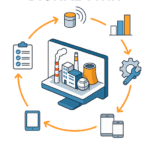Overview
Due to the combustion of fossil fuels and other human activities increasing greenhouse gas emissions, the world is now experiencing an unprecedented climatic catastrophe. One of the most promising methods to lower these gas emissions and lessen the consequences of climate change is to use carbon capture and utilization (CCU) technology.
Extracting carbon dioxide from industrial sources, such as steel mills, power plants, and other industrial facilities, is known as carbon capture and utilization (CCU). The trapped CO2 is used in various processes, from fuel or chemical manufacture to improved oil recovery. Recent years have seen a substantial increase in interest in this technology because of its potential to lower emissions while benefiting the industry economically. This article will discuss CCU’s potential and show how it might be used in various fields. We shall also consider its economic growth and environmental preservation advantages.
The first stage in obtaining CCU is collecting carbon dioxide from industrial sources, such as factories, power plants, etc. Depending on the fuel a company or facility uses, this may be done using several technologies, such as pre-combustion or post-combustion capture. While post-combustion captures employ chemical absorption techniques to remove carbon dioxide from exhaust gases after combustion, pre-combustion captures include separating CO2 before burning fuel. After being caught, the CO2 is sent to a storage or utilization facility where it may be used for various things.
Enhance oil recovery is one of the most popular uses of CCU (EOR). This entails pumping carbon dioxide into oil wells to raise their pressure and facilitate oil extraction. This technique has drastically reduced emissions while boosting oil output by over 10%. And CCU may be used in chemical processes that employ heat and pressure to transform collected CO2 into usable products, such as producing compounds like methanol, urea, and dimethyl carbonate (DMC). The potential uses for CCU technology have also been expanded by developing technologies like direct air capture, which enabled it to remove carbon dioxide broadly from ambient air rather than from industrial sources like power plants.
However, generally, implementing CCU helps reduce emissions while providing an economic benefit for industries by giving them a new revenue stream from selling their carbon credits or using their newly produced chemicals/fuels at competitive prices compared to existing ones in the market. The advantages of applying this technology are numerous and varied depending on how it’s applied across different sectors. And CCU may lessen climate change by lowering emissions of greenhouse gases and enhance air quality by reducing the quantity of CO2 emitted into the environment.
A range of situations, including product design, buying choices, and operational management, can benefit from applying LCCA.
CCU technology has much potential to boost the economy and considerably cut pollution. The technology is being used in several industries, including the oil industry, chemical manufacturing, and air capture, but further study must uncover its full potential and guarantee that its applications are carried out in a secure and long-lasting way. Governments should also enact regulations that encourage businesses to use this technology so it can actively contribute to the battle against climate change.
Technologies for Capture and Utilization (CCU)
Technologies for capturing and using carbon dioxide (CO2) from the atmosphere are called carbon capture and utilization (CCU) technologies. These technologies are being developed to provide an alternate energy source while reducing greenhouse gas emissions.
Carbon capture and storage is a CCU technology with the highest potential (CCS). CO2 is removed from the atmosphere, compressed, and then pumped underground as part of the CCS process. The ability to cut global CO2 emissions by up to 90% has been shown for this CO2 storage.
The power-to-gas CCU technology is another (P2G). This technique may create hydrogen gas (H2) from water. The CO2 is then added to the hydrogen gas to create a synthetic fuel, such as methanol or methane. Using this technique might cut world CO2 emissions by up to 80%.
Besides these methods, there are other recently developed ones like CO2 electrochemical reduction and direct air capture (DAC). While electrochemical reduction of CO2 includes turning CO2 into solid carbonates that may later be utilized as construction materials or energy storage, DAC directly absorbs CO2 from the atmosphere.
CCU technologies are a possible way to lessen the consequences of climate change by lowering global CO2 emissions. These innovations might provide an alternate energy source while reducing emissions by up to 90%. These technologies may play a significant role in the worldwide effort to mitigate climate change as they continue to develop.










